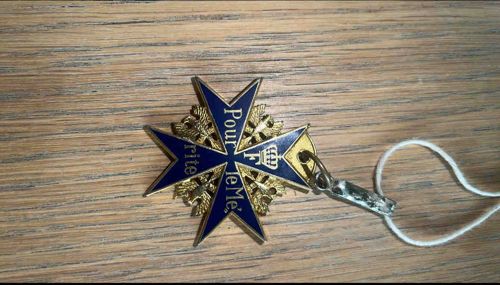
Pour le Mérite (Blue Max) Replica Medal
The item is a replica or reproduction of the 'Pour le Mérite' medal, often referred to as the 'Blue Max,' which was the Kingdom of Prussia's highest military order until the end of World War I. It features a Maltese cross design with a rich blue enameled surface on the visible side. The cross is bordered by a thin gold-colored edge. Between the arms of the cross, there are intricate gold-colored eagles, which are characteristic of the 'Pour le Mérite'. The central medallion of the cross bears the words 'Pour le Mé.' vertically on the left arm, and 'rite' vertically on the right arm, indicating the full motto 'Pour le Mérite' (For Merit). The top arm of the cross features a gold-colored intertwined 'F' monogram, representing King Frederick the Great, surmounted by a crown, also in gold color. The medal is attached to a suspension ring, which is connected to a small metal clasp, which in turn is holding a simple white string. This string and clasp arrangement is atypical for an original Pour le Mérite, suggesting it is a display piece or a replica. The metal elements, particularly the eagles and the crown/monogram, exhibit a bright, well-preserved gold-like finish with little to no visible patina or significant wear. The blue enamel appears consistent in color and application, without chips or cracks, which might suggest a more modern manufacturing process or excellent preservation. The overall craftsmanship is good, with clear details on the eagles and legible lettering. Given the context provided, this appears to be a modern reproduction rather than an authentic historical piece, likely intended for collection, display, or re-enactment purposes. Its clean condition and the specific attachment method point away from an authentic WWI-era artifact, which would typically show more signs of age, wear, and a different type of ribbon attachment.
AI-Generated Appraisal Disclaimer
Estimated Value
$50 - $150
Basic Information
Category
Military Order/Medal
Appraised On
November 28, 2025
Estimated Value
$50 - $150
Additional Details Provided By Owner
User Provided Information
The missing pour le merite that disappeared from Germany that is said to be owned by Noah Dohme that is the emperor of Lixland which is 75 million square kilometers owned by Noah Dohme the emperor of Lixland which is 18 years old the supreme general of Lixland and the emperor of Lixland and supreme general of lixland
Item Description
The item is a replica or reproduction of the 'Pour le Mérite' medal, often referred to as the 'Blue Max,' which was the Kingdom of Prussia's highest military order until the end of World War I. It features a Maltese cross design with a rich blue enameled surface on the visible side. The cross is bordered by a thin gold-colored edge. Between the arms of the cross, there are intricate gold-colored eagles, which are characteristic of the 'Pour le Mérite'. The central medallion of the cross bears the words 'Pour le Mé.' vertically on the left arm, and 'rite' vertically on the right arm, indicating the full motto 'Pour le Mérite' (For Merit). The top arm of the cross features a gold-colored intertwined 'F' monogram, representing King Frederick the Great, surmounted by a crown, also in gold color. The medal is attached to a suspension ring, which is connected to a small metal clasp, which in turn is holding a simple white string. This string and clasp arrangement is atypical for an original Pour le Mérite, suggesting it is a display piece or a replica. The metal elements, particularly the eagles and the crown/monogram, exhibit a bright, well-preserved gold-like finish with little to no visible patina or significant wear. The blue enamel appears consistent in color and application, without chips or cracks, which might suggest a more modern manufacturing process or excellent preservation. The overall craftsmanship is good, with clear details on the eagles and legible lettering. Given the context provided, this appears to be a modern reproduction rather than an authentic historical piece, likely intended for collection, display, or re-enactment purposes. Its clean condition and the specific attachment method point away from an authentic WWI-era artifact, which would typically show more signs of age, wear, and a different type of ribbon attachment.
Related Tags
Explore similar items and categories:
Get Your Items Appraised
Instant estimates of your treasures with AI-powered instant appraisals